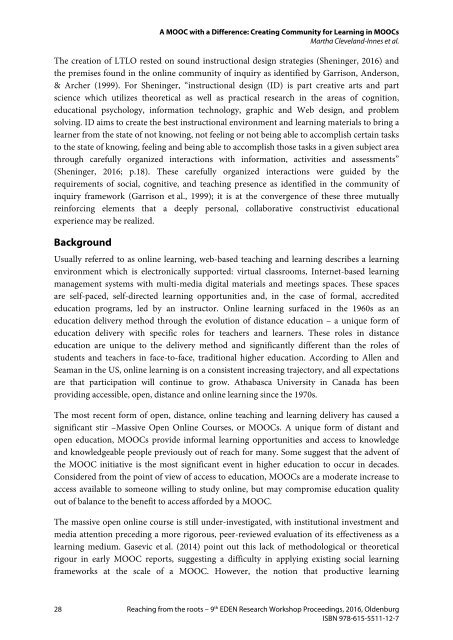Forging new pathways of research and innovation in open and distance learning
RW_2016_Oldenburg_Proceedings
RW_2016_Oldenburg_Proceedings
Create successful ePaper yourself
Turn your PDF publications into a flip-book with our unique Google optimized e-Paper software.
A MOOC with a Difference: Creat<strong>in</strong>g Community for Learn<strong>in</strong>g <strong>in</strong> MOOCs<br />
Martha Clevel<strong>and</strong>-Innes et al.<br />
The creation <strong>of</strong> LTLO rested on sound <strong>in</strong>structional design strategies (Shen<strong>in</strong>ger, 2016) <strong>and</strong><br />
the premises found <strong>in</strong> the onl<strong>in</strong>e community <strong>of</strong> <strong>in</strong>quiry as identified by Garrison, Anderson,<br />
& Archer (1999). For Shen<strong>in</strong>ger, “<strong>in</strong>structional design (ID) is part creative arts <strong>and</strong> part<br />
science which utilizes theoretical as well as practical <strong>research</strong> <strong>in</strong> the areas <strong>of</strong> cognition,<br />
educational psychology, <strong>in</strong>formation technology, graphic <strong>and</strong> Web design, <strong>and</strong> problem<br />
solv<strong>in</strong>g. ID aims to create the best <strong>in</strong>structional environment <strong>and</strong> learn<strong>in</strong>g materials to br<strong>in</strong>g a<br />
learner from the state <strong>of</strong> not know<strong>in</strong>g, not feel<strong>in</strong>g or not be<strong>in</strong>g able to accomplish certa<strong>in</strong> tasks<br />
to the state <strong>of</strong> know<strong>in</strong>g, feel<strong>in</strong>g <strong>and</strong> be<strong>in</strong>g able to accomplish those tasks <strong>in</strong> a given subject area<br />
through carefully organized <strong>in</strong>teractions with <strong>in</strong>formation, activities <strong>and</strong> assessments”<br />
(Shen<strong>in</strong>ger, 2016; p.18). These carefully organized <strong>in</strong>teractions were guided by the<br />
requirements <strong>of</strong> social, cognitive, <strong>and</strong> teach<strong>in</strong>g presence as identified <strong>in</strong> the community <strong>of</strong><br />
<strong>in</strong>quiry framework (Garrison et al., 1999); it is at the convergence <strong>of</strong> these three mutually<br />
re<strong>in</strong>forc<strong>in</strong>g elements that a deeply personal, collaborative constructivist educational<br />
experience may be realized.<br />
Background<br />
Usually referred to as onl<strong>in</strong>e learn<strong>in</strong>g, web-based teach<strong>in</strong>g <strong>and</strong> learn<strong>in</strong>g describes a learn<strong>in</strong>g<br />
environment which is electronically supported: virtual classrooms, Internet-based learn<strong>in</strong>g<br />
management systems with multi-media digital materials <strong>and</strong> meet<strong>in</strong>gs spaces. These spaces<br />
are self-paced, self-directed learn<strong>in</strong>g opportunities <strong>and</strong>, <strong>in</strong> the case <strong>of</strong> formal, accredited<br />
education programs, led by an <strong>in</strong>structor. Onl<strong>in</strong>e learn<strong>in</strong>g surfaced <strong>in</strong> the 1960s as an<br />
education delivery method through the evolution <strong>of</strong> <strong>distance</strong> education – a unique form <strong>of</strong><br />
education delivery with specific roles for teachers <strong>and</strong> learners. These roles <strong>in</strong> <strong>distance</strong><br />
education are unique to the delivery method <strong>and</strong> significantly different than the roles <strong>of</strong><br />
students <strong>and</strong> teachers <strong>in</strong> face-to-face, traditional higher education. Accord<strong>in</strong>g to Allen <strong>and</strong><br />
Seaman <strong>in</strong> the US, onl<strong>in</strong>e learn<strong>in</strong>g is on a consistent <strong>in</strong>creas<strong>in</strong>g trajectory, <strong>and</strong> all expectations<br />
are that participation will cont<strong>in</strong>ue to grow. Athabasca University <strong>in</strong> Canada has been<br />
provid<strong>in</strong>g accessible, <strong>open</strong>, <strong>distance</strong> <strong>and</strong> onl<strong>in</strong>e learn<strong>in</strong>g s<strong>in</strong>ce the 1970s.<br />
The most recent form <strong>of</strong> <strong>open</strong>, <strong>distance</strong>, onl<strong>in</strong>e teach<strong>in</strong>g <strong>and</strong> learn<strong>in</strong>g delivery has caused a<br />
significant stir –Massive Open Onl<strong>in</strong>e Courses, or MOOCs. A unique form <strong>of</strong> distant <strong>and</strong><br />
<strong>open</strong> education, MOOCs provide <strong>in</strong>formal learn<strong>in</strong>g opportunities <strong>and</strong> access to knowledge<br />
<strong>and</strong> knowledgeable people previously out <strong>of</strong> reach for many. Some suggest that the advent <strong>of</strong><br />
the MOOC <strong>in</strong>itiative is the most significant event <strong>in</strong> higher education to occur <strong>in</strong> decades.<br />
Considered from the po<strong>in</strong>t <strong>of</strong> view <strong>of</strong> access to education, MOOCs are a moderate <strong>in</strong>crease to<br />
access available to someone will<strong>in</strong>g to study onl<strong>in</strong>e, but may compromise education quality<br />
out <strong>of</strong> balance to the benefit to access afforded by a MOOC.<br />
The massive <strong>open</strong> onl<strong>in</strong>e course is still under-<strong>in</strong>vestigated, with <strong>in</strong>stitutional <strong>in</strong>vestment <strong>and</strong><br />
media attention preced<strong>in</strong>g a more rigorous, peer-reviewed evaluation <strong>of</strong> its effectiveness as a<br />
learn<strong>in</strong>g medium. Gasevic et al. (2014) po<strong>in</strong>t out this lack <strong>of</strong> methodological or theoretical<br />
rigour <strong>in</strong> early MOOC reports, suggest<strong>in</strong>g a difficulty <strong>in</strong> apply<strong>in</strong>g exist<strong>in</strong>g social learn<strong>in</strong>g<br />
frameworks at the scale <strong>of</strong> a MOOC. However, the notion that productive learn<strong>in</strong>g<br />
28 Reach<strong>in</strong>g from the roots – 9 th EDEN Research Workshop Proceed<strong>in</strong>gs, 2016, Oldenburg<br />
ISBN 978-615-5511-12-7


